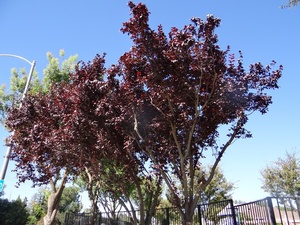Plum Trees are trees in section Prunus (Old World plums) or section Prunocerasus (New World plums) of subgenus Prunus of genus Prunus of the Amygdaleae tribe of the Amygdaloideae subfamily of the rose family. The genus Prunus also contains cherry trees, peach trees, apricot trees, and almond trees.
More distantly related, but also in the Amygdaloideae subfamily of the rose family, is the Maleae tribe, which includes apple trees, pear trees, hawthorn trees, cotoneaster, photinia, and toyon.
Plums are believed to have been one of the earliest fruits domesticated by humans. Several of the most commonly cultivated plum species have no close kin anywhere in the wild.
Native to Yolo County
Klamath Plum (Prunus subcordata), also called Sierra Plum, is a spiny, deciduous New World plum native to the Yolo County foothills (not including the Capay Hills). It usually grows 20 to 25 feet tall and spreads by root suckers to form dense thickets. In 20 years, it might grow 20 feet tall. It prefers partial shade. It has low water needs and requires excellent drainage. Its fruits ripen in late summer, turning red or yellow; they are small (one inch or less) and tart but edible.
Non-Native
 These three invasive weed Purple-leaf Plum (Prunus cerasifera) trees are planted at Jeff Roddy Memorial Park, right over the park sign at the front of the park. Photo by queerbychoice.Purple-leaf Plum (Prunus cerasifera), also called Cherry Plum, is an invasive weed from Europe and Asia. It is deciduous and usually grows 25 to 40 feet tall. Its fruits are edible, and some cultivars of it have been selected for fruit flavor; however, usually this species is planted primarily for its purple foliage. The fruits are dispersed by birds and other wildlife. U.C. Davis provides information on how to eradicate Purple-leaf Plum.
These three invasive weed Purple-leaf Plum (Prunus cerasifera) trees are planted at Jeff Roddy Memorial Park, right over the park sign at the front of the park. Photo by queerbychoice.Purple-leaf Plum (Prunus cerasifera), also called Cherry Plum, is an invasive weed from Europe and Asia. It is deciduous and usually grows 25 to 40 feet tall. Its fruits are edible, and some cultivars of it have been selected for fruit flavor; however, usually this species is planted primarily for its purple foliage. The fruits are dispersed by birds and other wildlife. U.C. Davis provides information on how to eradicate Purple-leaf Plum.
The City of Woodland has knowingly and intentionally planted Purple-leaf Plum at Freeman Park, Jeff Roddy Memorial Park, John Ferns Park, Pioneer Park, Ralph Harris Park, William Crawford, Sr., Park, Woodland Public Library, and Woodside Park. The city has also planted Purple-leaf Plum on 1st Street, 2nd Street, 3rd Street, 4th Street, 5th Street, Bartlett Avenue, Beamer Street, Carnegie Way, Cleveland Street, Clover Street, County Road 98, County Road 102, Court Street, Cross Street, Elm Street, Main Street, North Street, Pendegast Street, Pershing Avenue, Pioneer Avenue, Walnut Street, and West Keystone Avenue. In fact, the Urban Forest Resource Analysis published by the City of Woodland in 2018 indicated that the city was knowingly and intentionally maintaining 536 of these invasive weeds in Woodland.
European Plum (Prunus domestica) is a deciduous tree believed to be an autopolyploid form of the invasive weed Purple-leaf Plum (Prunus cerasifera); that is, it has extra chromosomes, but all of them seem to come from the invasive weed species Purple-leaf Plum. It has green foliage rather than purple, and it is usually grown for its edible fruit. European Plum has "perfect" flowers (containing both male and female parts). European Plum is planted in Avignon Park and at the Woodland Public Library. It is also planted as a street tree on College Street, Marshall Avenue, and Pendegast Street.
Purple-leaf Plumcot (Prunus × blireiana), also called Double-Flowering Plum, is a hybrid of the the invasive weed cultivar Purple-leaf Plum (Prunus cerasifera 'Pissardii') and the Japanese Apricot (Prunus mume). It usually grows 20 to 30 feet tall. Its foliage is purple-tinged when it first emerges but turns green as the season progresses. It is usually planted for its foliage and its double flowers; however, its fruits are edible.
Links
California Invasive Plant Council: Prunus cerasifera
Invasive.org: Prunus cerasifera


